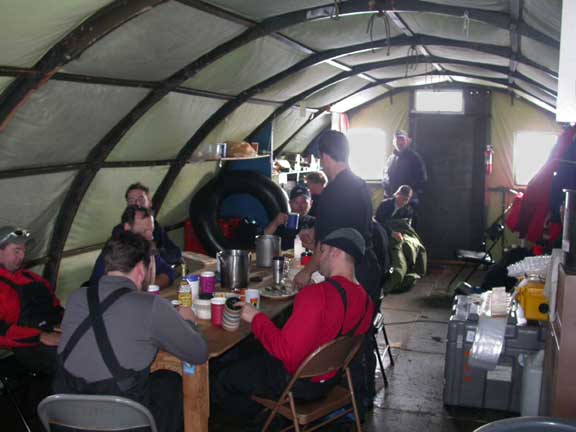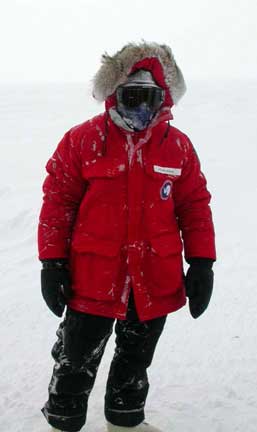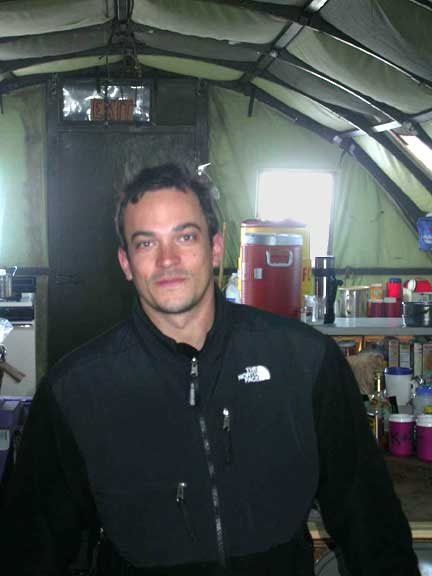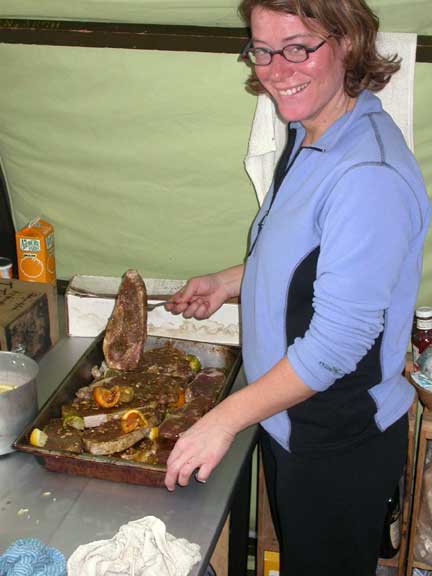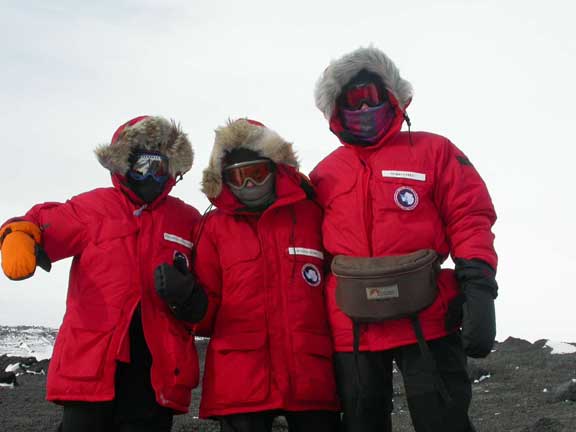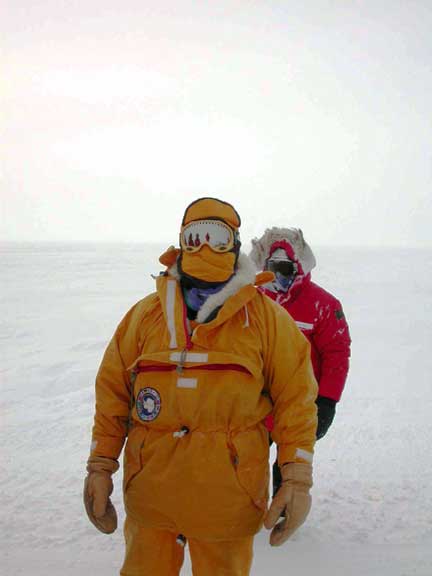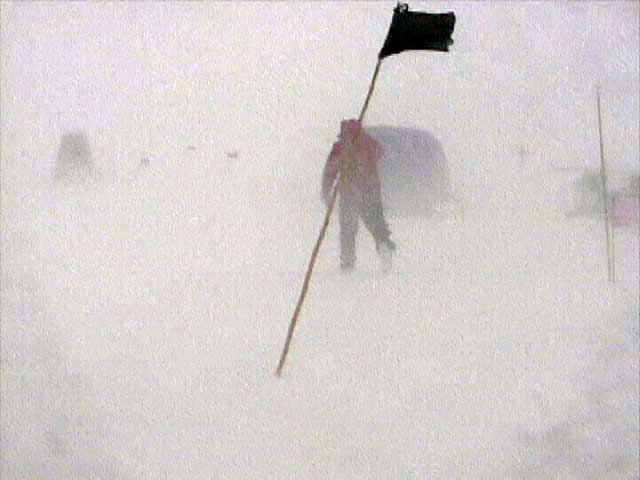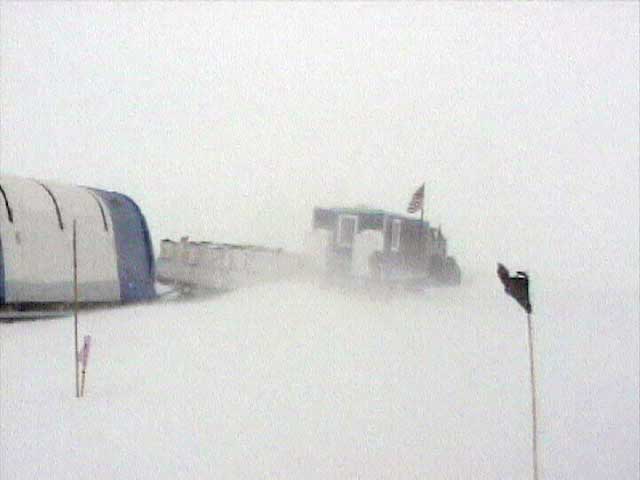
- 1999
- 2000
- 2001
- 2002
- 2003
- 2006
- 2007
Week 5 - November 25th to December 1, 2002
Date: 12/01/02
Latitude: 80 degrees South
Longitude: 120 degrees West
Temperature:−17°C( 1°F)
Wind speed: 17 knots
Wind Chill: −29°C ( −20°F)
Wind direction: Westerly
Meters of ice collected: 20
Notes on daily life:
It’s the first of December and so far it’s been a productive month for ITASE. We have worked out the kinks in the new two-inch drill and collected the first 20 meters of ice. Blue braved the cold on his snowmobile for hours and finished collecting his high–resolution three–dimensional GPS grid of the area around Byrd Surface Camp. The 160 kilometers of data that he collected will be used as part of his NASA fellowship to validate a new remote sensing satellite that will be launched in a just a few days. Steve, Gordon, and Jim spent the day collecting over 80 km of high–resolution radar data in a grid surrounding Byrd. The radar, GPS, and satellite data will be combined back in the States to provide a comprehensive analysis of snow accumulation, subsurface dynamics, and surface topography in the area surrounding Byrd. We also took full advantage of the amenities of Byrd and enjoyed another of Andrea’s wonderful dinners and then watched Monty Python’s Quest for the Holy Grail before heading off to bed still chuckling.
Date: 11/30/02
Latitude: 80 degrees South
Longitude: 120 degrees West
Temperature: −16°C( 5°F)
Wind speed: 10 knots
Wind Chill: −24°C /−11°F
Wind direction: North
Meters of ice collected: 15
Notes on daily life:
GPS grid, shallow and deep radar profiles.
Today we awoke to beautiful blue skies and a lovely fresh breakfast, thanks to Andrea. It is hard to believe that we are still at Byrd, but it does
have its good points. Byrd Camp has its own groomed ski way so that the LC–130 aircraft from McMurdo can deliver our precious cargo; it also has
a Jamesway shelter that is constantly warm.
After breakfast the whole team went to work in their respective science disciplines. Although we are stuck at Byrd for a few days, we can’t just sit around getting bored; we all have plenty of work to keep us busy. Brian and Steve conducted radar survey experiments on the ski way. Betsy and Markus prepared the atmospheric sampling tent for action and also conducted a helium balloon launch into the stratosphere. Eric, Paul, Mark, Susan and I drilled 15 meters of ice core with the 2–inch drill. Blue and Jim conducted shallow radar surveys. Lynn and Karl used the Caterpillar tractors to move heavy equipment around camp and plow away the large snowdrifts left by the storm. I think that perhaps the most important job completed today was that of Andrea and Gordon. They spent the whole afternoon preparing a brilliant Thanksgiving feast for us.
Although we are celebrating Thanksgiving a few days late, the spirit of the celebration is still with us. We ate heartily and made a toast to being safe and warm back at Byrd. At the moment I am sitting in the Jamesway, sipping red wine and watching a DVD movie on Eric’s laptop. Antarctica certainly has its moments, both good and otherwise…
Date: 11/29/02
Latitude: 80 degrees South
Longitude: 120 degrees West
Temperature: −16°C( 3°F)
Wind speed: 0 knots
Wind Chill: n/a
Wind direction: n/a
Meters of ice collected: 0
Notes on daily life:
We woke this morning to clear blue skies and calm conditions – quite a change from conditions for much of the past week. The same storm that shook us around a few days ago also seems to have ravaged Byrd Surface Camp. Some of the ski way marker flags have been blown over, Old Glory is in tatters at the top of the camp flag pole (although it was a new flag this season) and there are large snowdrifts surrounding the camp Jamesway tent.
After a breakfast of fresh eggs, we set about keeping ourselves busy for the day. Carl and Brian fired up the tractors and cleared away snow from around camp and groomed the ski way in anticipation of our resupply flight. Lynn worked his shovel, clearing away drifted snow from around camp structures and Andrea moved her gourmet kitchen operation back into the Jamesway. Mark worked on putting together the lightweight 2" drill which will be used to collect an ice core about 2 km outside of camp over the next few days. Markus and Betsy have moved their atmospheric sampling equipment about a kilometer upwind from camp where they are both busy preparing a full schedule of experiments for the next few days. Later this evening they will conduct a balloon launch, releasing a helium filled balloon that will rise up through the stratosphere measuring ozone concentrations along the way.
Blue, Gordon, Steve and Jim will use this extra time at Byrd to conduct a detailed mapping program, focusing on surface topography and snow accumulation. The project involves driving a 10 x 10 km grid on a snowmobile and sled equipped with precision GPS receivers and a ground penetrating radar. Each line in the grid will be spaced 1 km apart. The results of the survey will provide a detailed look at the topography and elevation of the ice sheet around Byrd and also a 3–dimensional view of snow accumulation over a relatively large area. Blue did the first part of the work today, driving an even more detailed grid over and across the bump that Byrd Surface Camp sits upon, while the others prepared the radar sled and the route coordinates for the remainder of the project.
The purpose of the experiment is to provide ground calibration and validation for a new satellite mission. ICESat (Ice, Cloud and Land Elevation Satellite) will be launched by NASA on December 19 to study changes in the polar ice sheets over the next five years using a laser altimeter. If the laser instrument is functioning properly it will measure the same surface topography and elevations from space that we measure during our experiment on the ground.
The work day ended with the team gathered back in the Jamesway, enjoying the relative treat of being able to eat our meals sitting at a table. Tomorrow we will celebrate Thanksgiving – Andrea is definitely thankful that she now has an oven in which to cook our holiday bird!
Date: 11/28/02
Latitude: 80 degrees South
Longitude: 120 degrees West
Temperature: −06°C( 21°F)
Wind speed: 5 knots
Wind Chill: −10°C( 14°F)
Wind direction: North
Meters of ice collected: 0
Notes on daily life:
At 3:42 am this morning I rolled over in my bunk near the roof of the kitchen. Something was different; it was quiet. The flag noise had abated. I opened my eyes, the kitchen was brighter than normal. I lay there wondering had the storm ended? I could not resist, I crawled out from under my covers, down the shelves that serve as my ladder to the upper bunk, struggled into my big boots, tromped across the kitchen, gave the iced up door a gigantic tug and peered outside. It was clear! I could see all the way to the atmospheric shelter some 300 meters away from camp. As I squinted into the bright light, I could see as far as the horizon. It was a beautiful, calm morning. The winds like a gentle breeze in comparison to the past few days' howlers.
Each day here has been a new adventure, we are definitely living one day at a time. New plans, new experiments and new weather keep us all engaged and living in the moment. After my foray outside I crawled back into my cozy bunk, thought about what the day would bring, and fell asleep for a few more precious hours of rest. The past few days have been a frenzy of storm related activity combined with attempts to begin our scientific programs.
Yesterday, Markus and I set up the atmospheric shelter, programmed the computers, warmed up the sensor instruments, and by midday everything was in full swing. At each site, we are collecting a wide spectrum of data that gives us a picture of the current local atmospheric conditions and chemical concentrations. In all we have eight experiments. To get these all up and running takes us a full day or two of work. First we must unpack the shelter, mix reagents, calibrate the instruments, connect the snow temperature probes, then we set up the air intake lines and the meteorological instruments. Finally all of the instruments and experiments need electricity to run, so the generator must be fueled and started. The last few days have had the added challenge of unrelenting strong wind, cold and blowing snow, and near–zero visibility. When I peeked out this morning I felt a welcome relief to see the calm. It will make our lives so much easier.
However, even though the weather conditions improved, the frenzy of activity around camp continued. It is moving day again, so the trains had to be freed from their snow–drifted states, in some cases this meant digging several feet of snow off the sleds. While everyone pitched in to get the trains in order for departures, Markus and I wrapped up our work and repacked his shelter. We have been waiting for a chance to move our equipment back to Byrd Station where we will await the arrival of a better fuel hauling sledge and some wider tracks for our narrow tracked Challenger tractor. These pieces of equipment are now being sent to us from around the world so that we can make our way through the heavy snow that has accumulated in this area. As of tonight, we are back at Byrd station. It is a Happy Thanksgiving here with the ITASE team.
Date: 11/27/02
Latitude: 80 degrees, 21 minutes South
Longitude: 118 degrees, 14 minutes West
Temperature: −10°C( 14°F)
Wind speed: 35 knots
Wind Chill: −23°C(−9°F)
Wind direction: Northeast
Meters of ice collected: 0
Notes on daily life:
Today was a mismatch of raw, primitive Antarctic weather and gentler, modern conveniences. The two highlights were the wonderful steak dinner that Andrea made for everyone, which was followed by a DVD showing of Lord of the Rings. Dining on such wonderfully prepared food and then enjoying a movie in comfort with friends belied the fury of the Antarctic storm that was howling outside. We’ve been in the same weather pattern for the past three days now, and it is still an amazing experience every time a person heads outside.
The area of Antarctica where we are is one of the flattest, most featureless terrain on the planet. In every direction one looks there is a limitless expanse of flat whiteness. However, since the storm has arrived, the blowing snow has reduced visibility to less than 5 feet! With sustained winds of 30 knots and gusts reaching into the 40s it seems like every snow crystal within a thousand kilometers has become mobilized in the air. The ensuing whiteout conditions have created a truly ethereal experience where all sense of depth and distance are gone. There is no horizon: only white. It is a blankness that seems to defy logic; does it go on forever or nowhere? Even a simple, stumbling trip from the Blue Room to the kitchen forces one to realize the awesome and alien character of this land. Despite the steaks and DVDs this is still a wild place. Luckily we have flag lines to follow and warm shelters to keep us safe, so overall the storm is more an impressive experience than a truly worrisome threat. However, every venture outside makes you wonder if the ice is choosing to remind us that it might be tolerating our diesel engines, wind generators, and computers but it is still a powerful continent demanding respect.
Date: 11/26/02
Latitude: 80 degrees, 21 minutes South
Longitude: 118 degrees, 14 minutes West
Temperature: −15°C( 5°F)
Wind speed: 30 knots
Wind Chill: −29°C /−20°F
Wind direction: North Northeast
Meters of ice collected: 0
Notes on daily life:
It's a blustery day in camp today. The wind has remained at a constant 30 knots with gusts as high as 45 knots, and visibility is limited by surface blowing snow. The strong winds make everything more difficult; camp becomes drifted in by blowing snow, care must be taken to keep things from blowing away, and in order to walk between shelters, one must lean into the wind. Flags are placed every ten feet between the sleds, the outhouse and atmospheric tent for safe travel between locations. The high winds cause the American flag on the kitchen roof to beat incessantly on the wall, and when winds gust above 35 knots the wind generator mounted on the blue room sounds like a loud chain saw and can be heard throughout camp.
The soft surface snow caused by El Niño conditions is making travel difficult. Earlier this morning Paul, Gordon, Lynn, Karl and Brian set up one of the trains with the wide track Challenger, a Berco sled loaded with fuel, another Berco with food and ice core boxes, the 3" drill sled, the polar haven, and the deep radar. They intended to shuttle the load of gear to site 1 (224 km from our current location), but the fuel sled was too heavy for these snow conditions and the tracks on the Challenger didn't have enough traction to pull the heavy load. After the storm ceases the snow conditions may improve.
Back in camp we're keeping busy with fieldwork and processing data. Markus and Betsy are busy setting up the atmospheric chemistry experiments, and when the winds die down they will launch an ozone detecting balloon. Eric and Dan have been collecting surface snow samples, and with improved conditions we will begin to drill ice cores with the 2" drill. In the meantime, we're taking advantage of the time to work with our data, collaborate between science groups, and plan other work that we will do this field season.
Tonight we enjoyed another gourmet dinner cooked by Andrea; salmon, couscous, and Moroccan stew. Some of the group wrapped up the night by watching a DVD in the blue room, and in the kitchen we cranked up the music and had a dance party.
Date: 11/25/02
Latitude: 80 degrees, 21 minutes South
Longitude: 118 degrees, 14 minutes West
Temperature: −20°C(−4°F)
Wind speed: 23 knots
Wind Chill: −34°C(−30°F)
Wind direction: East
Meters of ice collected: 0
Notes on daily life:
One of the main goals of ITASE is to study global climate change and there has been a specific focus on determining the global effects of El Niño. This year’s El Niño has caused a dramatic increase in snowfall in West Antarctica. The fresh snow makes travel a bit more difficult. It took us over three hours to go our first three kilometers yesterday and while things did improve somewhat, we were never able to reach our planned speed. We slogged for 12 hours through the thick snow and finally called a break at 2 a.m. when we became mired once again. Over those 12 hours we had not covered as much ground as originally planned. After climbing into our bunks for a few hours of sleep, we awoke this morning to take stock of the situation.
Perhaps the one truth about planning for expeditions like this is that you have to be flexable. We all put our heads together to think of options. A trip of this scope is a marvel of planning and logistics and changes are not easy. Paul, as our field leader, developed a plan and then sorted through the issues to find the most appropriate solution. Difficult questions nagged at us, such as: could we still guarantee that we would arrive at the Pole in time for people to make it back to the their teaching commitments in the States? Could we take all of our sleds and equipment to the Pole? Throughout the day all of these questions were seriously confronted and examined. Over the course of numerous meetings, and satellite phone calls to McMurdo, a plan began to emerge and evolve. Our main challenge right now is the deep, soft snow. This has caused our heavy fuel sleds to burrow into the snow more than expected and has also prevented our narrow–tracked Challenger from being as effective as we had hoped. We have two Challenger tractors; but only one is fitted with special extra wide tracks that allow it to function better in snow. After some logistical wrangling and extensive recalculations along with a hearty dose of Antarctic resolve we devised a new plan that will still bring our entire team to the South Pole.
On a positive note, both the deep and shallow sounding radars have been working wonderfully and have produced some great data. This is especially true of Brian’s deep sounding unit that has already produced some interesting deep stratigraphic profiles. Tomorrow we shall begin our new, revamped traverse with the same dedication, determination, and decisiveness that has marked our group since the beginning. See you at the Pole!
